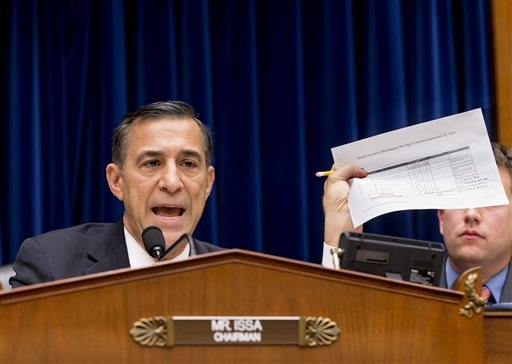Fewer than 27,000 signed up for health insurance using federal website

WASHINGTON — Putting a statistic on disappointment, the Obama administration revealed Wednesday that fewer than 27,000 people signed up for private health insurance last month in the 36 states relying on a problem-filled federal website.
States running their own enrollment systems did better, signing up more than 79,000, for a total enrollment of over 106,000.
Still, that was barely one-fifth of the nearly 500,000 people administration officials had projected would sign up the first month of Obama’s signature program, a numerical rebuke to the administration’s ability to deliver on its promise. The 106,185 people who made it all the way through to selecting a plan represent just 1.5 percent of the 7 million people the administration hopes to enroll by next year.
Health and Human Services Secretary Kathleen Sebelius said things will get better, and quickly.
“There is no doubt the level of interest is strong,” she said.
The administration said an additional 1 million or so applicants have been found eligible for government-subsidized private coverage in new state-level insurance markets, and about half are within sight of having their plans lined up for the start of next year. An additional 396,000 have been found eligible for Medicaid, the safety-net program that is shaping up as the health care law’s early success story.
The numbers landed amid a political storm on Capitol Hill. Democrats who had hoped to run for re-election next year on the success of the health care law are increasingly worried.
It’s not only the website woes, but a wave of cancellation notices hitting constituents whose individual health insurance policies don’t measure up to the law’s requirements. Senate Majority Leader Harry Reid, D-Nev., has scheduled an all-Democrats meeting Thursday with White House health care officials.
The administration has staked its credibility on turning the website around by the end of this month. From the president on down, officials have said that HealthCare.gov will be running smoothly for the vast majority of users by Nov. 30.
Some outside experts are concerned. “People are starting to get nervous because there is not enough indication from the government that things are on track,” said Caroline Pearson, who runs thehealth reform practice at Avalere Health, a market analysis firm. “You wonder if there are still underlying programming problems that are causing the system to shut down when volume is high.”
Administration officials have not specified what “running smoothly” means, or what would constitute the “vast majority” of users.
On daily media calls, Health and Human Services department officials have described a situation where problems get fixed and then new issues crop up as consumers are able to venture further into the website. It’s a bit like traffic heading back to a city late on a summer Sunday: You get past one jam, and odds are you run into another.
There was a hopeful sign this Tuesday when Julie Bataille, HHS communications director for the rollout, said that 275,000 people who got hung up in the early days are being invited back to try to complete their applications. The administration is sending the email invitations in batches, so as not to risk any disruptions. White House chief technology officer Todd Park told Congress on Wednesday that system response times are much faster, and error rates have plunged.
But other signals have raised questions. In a blog post on Saturday, Bataille quoted chief White House troubleshooter Jeff Zients as saying improvements would continue in “December, January, February — just like you do with any website.”
Asked whether the Nov. 30 target was still achievable, Bataille said on Tuesday, “I want to be clear that our plan remains the same. We are on a path to make improvements week by week so that by the end of November, the site will be working for the vast majority of users.”
It’s unlikely that Congress will let the effort keep floundering much beyond Nov. 1. Millions of lawmakers’ constituents are losing current individual policies that don’t meet the law’s requirements. To guarantee they don’t experience a break in coverage they would have to select new plans by Dec. 15. That’s a major political problem for Democrats who so far have stood by the president.
The main federal website is central because other enrollment routes, from call centers to counselors to paper applications received by mail, all depend on having that access.
“They either need to get HealthCare.gov up and functioning smoothly, or they need to come up with work-arounds so enrollments can be processed without going through the website,” Pearson said.
In Congress earlier Wednesday, the House’s chief investigator plunged into the technical issues behind the dysfunctional rollout.
Rep. Darrell Issa, R-Calif., chairman of the House Oversight and Government Reform Committee, is investigating a long list of issues: insufficient testing, possible security flaws, design shortcomings — even allegations of political meddling.
But as his hearing went on, there didn’t seem to be a “smoking gun” behind the technical failure that has mortified supporters of the health care law and cheered its opponents. The technology’s cost to taxpayers: north of $600 million and climbing.
It was the sixth major congressional hearing since computerized insurance markets went live Oct. 1 and millions of consumers encountered frozen screens. The oversight committee was sharply divided along partisan lines.
“Established best practices of our government were not used in this case,” said Issa. As a result, the law’s promise of affordable health insurance “does not exist today in a meaningful way.” Like other Republicans, Issa wants the law repealed, not fixed.
Ranking Democrat Elijah Cummings of Maryland questioned Issa’s fairness.
Addressing Issa directly, Cummings said: “Over the past month, instead of working in a bipartisan manner to improve the website, you’ve politicized this issue by repeatedly making unfounded allegations.”
———
Associated Press writer Anne Flaherty contributed to this report.